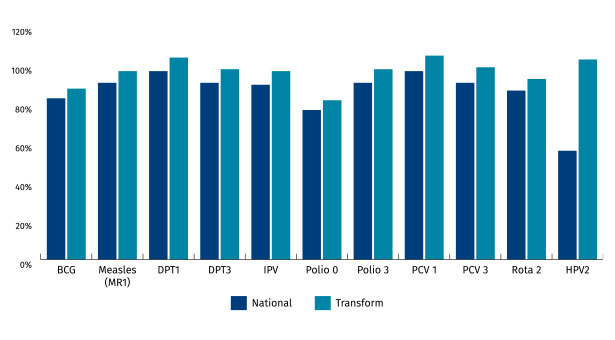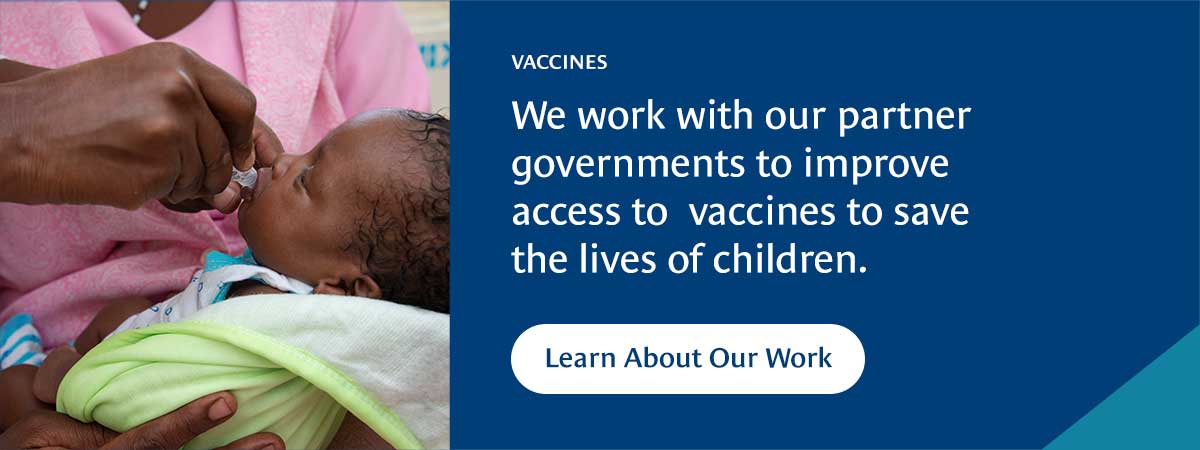Effective interventions to increase routine immunization uptake in health facilities
BACKGROUND
In November 2020, CHAI Uganda’s vaccines team set out to help the government address challenges with routine immunization service delivery and improve equity across 14 districts representing around 11 percent of the country’s children under five—about 952,000[1] children.
Missed opportunities for vaccinations (MOVs) occur when children visit health facilities, whether for their own care or accompanying a caretaker, and are not screened or provided with the vaccinations they require. In Uganda, these visits represent a large-scale unrealized opportunity to increase vaccine uptake and ensure completion of a child’s full immunization schedule, which is critical for full protection both to the child and the community against vaccine-preventable diseases.
A CHAI assessment in December 2018 found that in the 14 focus districts, only 42 percent of health facilities conducted systematic screening for vaccination. When screening did occur, 26 percent of children dropped out between the screening and immunization points. The CHAI assessment also revealed access challenges faced by caretakers. For instance, 42 percent of those surveyed reported that vaccination hours are incompatible with their schedule and 35 percent reported long waiting times as a deterrent.
APPROACH
CHAI identified limited immunization session availability and ineffective referrals as key factors contributing to MOVs in health facilities. CHAI used this information to align with the Uganda Expanded Program for Immunization (UNEPI) on interventions to address the identified challenges through a series of consultative meetings.
To reduce MOVs and increase vaccine uptake, CHAI is supporting health facilities to implement daily static immunization sessions, screen every child that visits a health facility, and ensure immunizations are offered and available to all eligible children. To reach the most children in need, this work is focused on the 10 high-volume facilities with the highest numbers of unimmunized children in each of the 14 districts.
To enable this work, CHAI trained national supervisors to mentor health workers to screen and vaccinate all eligible children, including those referred from other clinical departments or facilities. Eligible children are vaccinated within the department where they are screened, otherwise, they are referred internally to the immunizing unit or department.
While daily immunization sessions are part of the national Immunization in Practice (IIP) guidance, they were often not implemented. To address this, the team is supporting clinics to concurrently optimize clinical workflows, including task shifting to increase healthcare workers’ capacity to implement daily immunization sessions in line with the national immunization policy. Health facilities also receive support to better communicate with local communities about the daily availability of immunization services. In addition, involvement of and leadership from local political and technical stakeholders has been critical to the implementation of this intervention, including facility managers, district health officers, and sub-county chiefs.
The impact is monitored through weekly tracking of key immunization indicators in child registers which enables health workers to visualize probable under attainment of the monthly target which triggers mitigation actions before the end of the month. This activity is supported by quarterly data review meetings, providing an opportunity for interaction between health and non-health stakeholders to address routine immunization challenges driven by non-health sector factors. This approach has the potential to become part of routine planning processes for vaccination and other primary healthcare services.
IMPACT
At the health facility level, systematic screening for vaccination and daily static immunization sessions have increased by 58 percent and 39 percent respectively between December 2018 (baseline) and November 2021 (end-line). As a result, 11 percent more children have received their third dose of diphtheria, tetanus, and pertussis vaccine (DTP3), and 72 percent more children received the second dose of human papillomavirus vaccine (HPV2) in September 2021 compared to the same month in 2020, before the implementation of the interventions. In addition, the 14 focus districts have consistently achieved higher vaccination coverage than the national average between January and December 2021 as indicated in Figure 1.

Figure 1: 2021 Immunization coverage rates National vs 14 CHAI supported districts
The intervention has positively impacted the experience of caretakers, children, and service providers. Previously, all mothers and children would attend health facilities on the same day of the week for immunization services, creating long waiting times and a sporadic increase in workload for health workers. These workers have found that spreading immunization sessions across the week helps to reduce their workload.
Limitations to implementing daily immunization sessions in some health facilities have included vaccine stockouts, non-functioning cold chain, redistribution of trained health workers to other sites. To address these challenges in lower-performing health facilities, CHAI established peer support activities, including peer mentoring sessions and setting up WhatsApp groups to review weekly performance and discuss challenges and best practices.
MOVING FORWARD
The intervention districts have outperformed national routine immunization coverage over the last year. These results, albeit provisional, are critical in the context of ongoing COVID-19 disruptions to health services, which have negatively impacted infant vaccination coverage rates in many countries. The interventions are informing service delivery models and the development of the Uganda National Immunization Strategy 2022 – 2026 to support the recovery of immunization coverage to pre-COVID levels and beyond.
[1] 2020 UBOS Population projections






